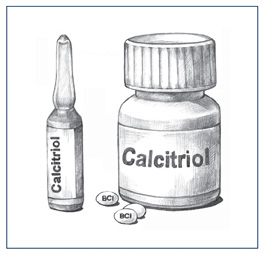Growth Failure in Children With Kidney Disease
On this page:
How do the kidneys affect a child’s growth?
In addition to removing wastes and extra fluid from the blood, the kidneys perform several functions important for a child’s growth, including
- helping regulate the amounts and interactions of nutrients from food, including minerals like calcium, phosphorus, and vitamin D
- maintaining the proper acid-base balance in the blood
- producing the hormone erythropoietin (EPO), which promotes red blood cell production
- playing a possible role in the metabolism of growth hormone, also called somatotropin
Calcium and vitamin D are essential for normal bone growth. The kidneys turn vitamin D into an active hormone called calcitriol that helps bones absorb the right amount of calcium from blood. The kidneys also eliminate excess phosphorus. If the kidneys are impaired, bones do not get enough calcium either because the kidneys fail to turn vitamin D into calcitriol or because they let too much phosphorus build up in the blood. The excess phosphorus draws calcium into the blood and blocks calcium from getting to the bones.
[Top]
How is growth failure treated?
The child’s doctor may recommend a number of strategies to treat growth failure.
Low-phosphorus Diet
Dietary changes involve limiting foods that are high in phosphorus, like milk and other dairy products. Cream cheese and cottage cheese are acceptable low-phosphorus dairy foods. High-phosphorus foods also include meat, fish, and poultry and some vegetables like broccoli, peas, and beans. Dark breads, like whole wheat and pumpernickel, and many cereals are also high in phosphorus. Because avoiding all of these foods is almost impossible, caregivers must work with a dietitian to find a healthy way to limit phosphorus in the child’s diet while still providing enough calories and other nutrients for growth and health. Learning the phosphorus content of foods and measuring portions can help control phosphorus intake.

Learning the phosphorus content of foods and measuring portions can help control phosphorus intake.
Phosphate Binders
In addition to limiting phosphorus in the child’s diet, the doctor may recommend a phosphate binder. This medicine binds some of the phosphorus in the bowel so that it is excreted in the child’s stool. Phosphate binders come in the form of chewable tablets, liquids, capsules, and pills. Some children can use over-the-counter antacid tablets as phosphate binders because they contain calcium. A calcium-free binder may be prescribed if calcium buildup in the blood is a concern. The child should take the phosphate binder with meals and only according to the doctor’s recommendations.
Nutritional Supplements
Children with advanced kidney disease may lose their appetite or lack the energy to eat. These children may need nutritional supplements to support growth. In some cases, tube feeding is required. While drastic, tube feeding is often the best way to ensure a child gets the full supply of fluid and nutrients needed to promote growth and development. Feeding tubes are most often used in infants, but sometimes older children and adolescents benefit from them as well. See the fact sheet Nutrition in Children with Chronic Kidney Disease from the National Kidney and Urologic Diseases Information Clearinghouse (NKUDIC) for more information.
Calcitriol and Other Vitamin D Medications
Children with chronic kidney disease may also need to take a synthetic form of calcitriol or a similar vitamin D medication to help the bones absorb calcium and help build bones. These medications also help in the growth process. These supplements may be administered by injection or taken orally in pill form.

Children with chronic kidney disease may need to take a synthetic form of calcitriol or a similar vitamin D medication.
Alkaline Agents
The doctor may prescribe sodium bicarbonate or some other alkaline agent to restore the acid-base balance in a child with acidosis—high levels of acid in the blood. Acidosis resulting from chronic kidney disease can disrupt growth.
Erythropoietin (EPO)
Children with chronic kidney disease may develop anemia. Anemia is the shortage of red blood cells, which deliver oxygen throughout the body. Lack of oxygen can lead to fatigue and poor growth. The kidneys support the production of red blood cells by making the hormone EPO. Kidney disease decreases the production of EPO, causing anemia. The doctor may prescribe a man-made form of EPO given by injection to treat this problem.
Growth Hormone
If the child is very short as a result of kidney disease, some doctors prescribe injections of human growth hormone. Almost all pediatric nephrologists believe that the availability of growth hormone has been an important advance in the treatment of small children with chronic kidney disease. Most studies suggest that growth hormone stimulates growth in children with chronic kidney conditions or children undergoing maintenance dialysis treatment or transplantation.
[Top]
Points to Remember
- The kidneys play an important role in a child’s growth.
- The kidneys help regulate the amounts and interactions of nutrients from food, including minerals like calcium, phosphorus, and vitamin D, that are necessary for growth.
- If the kidneys are impaired, bones do not get enough calcium either because the kidneys fail to turn vitamin D into calcitriol or because they let too much phosphorus build up in the blood.
- Growth failure is treated with
- low-phosphorus diet
- phosphate binders
- nutritional supplements
- calcitriol and other vitamin D medications
- alkaline agents
- erythropoietin (EPO)
- growth hormone
[Top]
Hope through Research
The National Institute of Diabetes and Digestive and Kidney Diseases (NIDDK) conducts and supports research to help people of all ages with kidney disease. The NIDDK’s Division of Kidney, Urologic, and Hematologic Diseases (KUH) maintains the Pediatric Nephrology Program, which supports research into the causes, treatment, and prevention of kidney disease in children. In 2003, the KUH division began the Prospective Study of Chronic Kidney Disease in Children to learn more about the negative effects of pediatric kidney disease, including cardiovascular disease and growth failure. That study is ongoing.
Participants in clinical trials can play a more active role in their own health care, gain access to new research treatments before they are widely available, and help others by contributing to medical research. For information about current studies, visit www.ClinicalTrials.gov.
[Top]
For More Information
American Kidney Fund
6110 Executive Boulevard, Suite 1010
Rockville, MD 20852
Phone: 1–800–638–8299 or 301–881–3052
Email: helpline@kidneyfund.org
Internet: www.kidneyfund.org
American Society of Pediatric Nephrology
3400 Research Forest Drive, Suite B7
The Woodlands, TX 77381
Phone: 281–419–0052
Fax: 281–419–0082
Email: info@aspneph.com
Internet: www.aspneph.com
National Kidney Foundation
30 East 33rd Street
New York, NY 10016
Phone: 1–800–622–9010 or 212–889–2210
Fax: 212–689–9261
Internet: www.kidney.org
The National Kidney and Urologic Diseases Information Clearinghouse collects resource information about kidney and urologic diseases for the NIDDK Reference Collection. This database provides titles, abstracts, and availability information for health information and health education resources.
You may view the results of the automatic search on growth failure in children with kidney failure. If you wish to perform your own search of the database, go to NIDDK Reference Collection.
This publication may contain information about medications. When prepared, this publication included the most current information available. For updates or for questions about any medications, contact the U.S. Food and Drug Administration toll-free at 1–888–INFO–FDA (463–6332) or visit www.fda.gov. Consult your doctor for more information.
[Top]
Acknowledgments
Publications produced by the Clearinghouse are carefully reviewed by both NIDDK scientists and outside experts. The NKUDIC would like to thank Barbara Fivush, M.D., and Kathy Jabs, M.D., of the American Society of Pediatric Nephrology (ASPN), for coordinating the review of the original version of this publication by the ASPN’s Clinical Affairs Committee: Tej Mattoo, M.D.; William Primack, M.D.; Joseph Flynn, M.D.; Ira Davis, M.D.; Ann Guillott, M.D.; Steve Alexander, M.D.; Deborah Kees-Folts, M.D.; Alicia Neu, M.D.; Steve Wassner, M.D.; John Brandt, M.D.; and Manju Chandra, M.D. Frederick Kaskel, M.D., Ph.D., president, ASPN, and Sharon Andreoli, M.D., secretary-treasurer, ASPN, also provided comments and coordination.
[Top]
National Kidney and Urologic Diseases Information Clearinghouse
3 Information Way
Bethesda, MD 20892–3580
Phone: 1–800–891–5390
TTY: 1–866–569–1162
Fax: 703–738–4929
Email: nkudic@info.niddk.nih.gov
Internet: www.kidney.niddk.nih.gov
The National Kidney and Urologic Diseases Information Clearinghouse (NKUDIC) is a service of the National Institute of Diabetes and Digestive and Kidney Diseases (NIDDK). The NIDDK is part of the National Institutes of Health of the U.S. Department of Health and Human Services. Established in 1987, the Clearinghouse provides information about diseases of the kidneys and urologic system to people with kidney and urologic disorders and to their families, health care professionals, and the public. The NKUDIC answers inquiries, develops and distributes publications, and works closely with professional and patient organizations and Government agencies to coordinate resources about kidney and urologic diseases.
Publications produced by the Clearinghouse are carefully reviewed by both NIDDK scientists and outside experts.
This publication is not copyrighted. The Clearinghouse encourages users of this publication to duplicate and distribute as many copies as desired.
NIH Publication No. 09–4569
January 2009
[Top]
|






